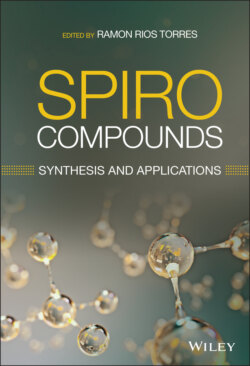Читать книгу Spiro Compounds - Группа авторов - Страница 25
3.2.3 Organometallic Miscellaneous Strategies to Construct Spiro Compounds
ОглавлениеThe following reports are based on the construction of strained small ring spirocyclic scaffolds and on the utilization of merged metal‐ and organocatalytic strategies. The first example deals with an enantioselective [2+2] cycloaddition of disubstituted ketenes 114 and isatins 115 for the synthesis of spirocyclic β‐lactones 116, reported by the group of Feng in 2014 (Scheme 3.11) [22]. The method utilizes Sc(OTf)3 as Lewis acid catalyst in the presence of the chiral N,N′‐dioxide ligand 117, responsible for controlling the stereochemistry of the product 116. A variety of chiral β‐lactones were obtained in excellent yield (80–96%) with very high diastereo‐ and enantioselectivity (>20 : 1 dr and 88–97% ee).
Scheme 3.10 Ni‐catalyzed asymmetric Diels–Alder/[3,3]sigmatropic rearrangement cascade between methyleneindolinones with 1‐thiocyanatobutadienes.
Source: Modified from Zhou et al. [20].
In 2015, Tanaka and coworkers outlined an enantioselective [2+2+2] cycloaddition approach to construct spiro‐cyclohexadienes 123, starting from terminal alkynes 124, acetylenedicarboxylates 125, and cyclopropylideneacetamides 126 (Scheme 3.12) [23].
Scheme 3.11 Scandium‐catalyzed asymmetric cycloaddition between ketenes and isatins.
Source: Modified from Hao et al. [22].
Scheme 3.12 Rhodium‐catalyzed [2+2+2] cycloadditions between alkynes and cyclopropylideneacetamides.
Source: Based on Yoshida et al. [23].
In the reported reaction mechanism, a rhodium(I)/(S)‐binap cationic complex is responsible for the excellent stereocontrol (96%–>99% ee), affording the spiro cyclohexadiene products 123 in moderate to good yield (31–76%). Mechanistically, the reaction proceeds through the formation of intermediate 127 by coupling the two terminal alkynes 124 and 125 with cyclopropylideneacetamides 126 in the presence of Rh(I) complex. Regioselective insertion of 126 produces the intermediate 127 which undergoes direct reductive elimination to furnish the final spiranic product 123. In a subsequent report, the authors extended the scope of the [2+2+2] cycloaddition to 1,6‐enynes instead of alkynes [24].
In 2018, the group of Rios reported an enantioselective synthesis of spiropyrazolones 135 by a formal [6+2] cycloaddition reaction (Scheme 3.13) [25]. The method relies on the catalytic synergistic activation of the seven‐membered pyrazolone derivatives 136 by Pd along with the activation of enals 137 by the chiral secondary amine 138. Specifically, the reaction is initiated by the simultaneous formation of highly active Pd‐complex 139 and the chiral iminium ion intermediate 140. Stereoselective interception of the iminium ion by the nucleophilic Pd‐complex 139 provides the enamine intermediate 141 bearing the Pd‐coordinated allyl cation. Intramolecular ring closing between the enamine moiety and allyl cation in 141 furnishes the final spiranic products 135. The [5,5]spiropyrazolone products are obtained in good yields (54–79%), moderate to good diastereoselectivities (3.2 : 1 to 20 : 1), and excellent enantiocontrol (93%–>99%).
Scheme 3.13 Synergistic palladium/chiral secondary amine‐catalyzed formal ring contraction for the enantioselective synthesis of spiropyrazolones.
Source: Modified from Meazza et al. [25].
